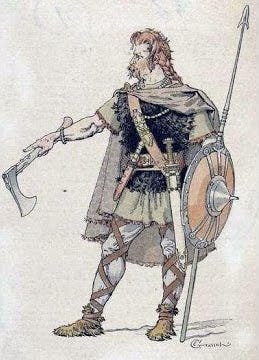THE ART OF WAR IN THE MIDDLE AGES 08
The Infantry of the Franks in the 6th Century
2.02. The Infantry of the Franks in the 6th Century
The Teutonic nation of North-Western Europe did not, like the Goths and Lombards, owe their victories to the strength of their mail-clad cavalry. The Franks and Saxons of the sixth and seventh centuries were still infantry. It would appear that the moors of North Germany and Schleswig, and the heaths and marshes of Belgium, were less favourable to the growth of cavalry than the steppes of the Ukraine or the plains of the Danube valley. The Frank, as pictured to us by Sidonius Apollinaris, Procopius, and Agathias, still bore a considerable resemblance to his Sigambrian ancestors. Like them he was destitute of helmet and body-armour; his shield, however, had become a much more effective defence than the wicker framework of the first century: it was a solid oval with a large iron boss and rim. The framea had now been superseded by the angon, ‘a dart neither very long nor very short, which can be used against the enemy either by grasping it as a pike or hurling it.’ The iron of its head extended far down the shaft; at its neck were two barbs, which made its extraction from a wound or a pierced shield almost impossible.
The francisca, however, was the great weapon of the people from whom it derived its name. It was a single-bladed battle-axe, with a heavy head composed of a long blade curved on its outer face and deeply hollowed in the interior. It was carefully weighted, so that it could be used, like an American tomahawk, for hurling at the enemy. The skill with which the Franks discharged this weapon, just before closing with the hostile line, was extraordinary, and its effectiveness made it their favourite arm. A sword and dagger (scramasax) completed the normal equipment of the warrior; the last was a broad thrusting blade, 18 inches long, the former a two-edged cutting weapon of about 2½ feet in length.
Such was the equipment of the armies which Theodebert, Buccelin, and Lothair led down into Italy in the middle of the sixth century. Procopius informs us that the first-named prince brought with him some cavalry; their numbers, however, were insignificant, a few hundreds in an army of 90,000 men. They carried the lance and a small round buckler, and served as a bodyguard round the person of the king. Their presence, though pointing to a new military departure among the Franks, only serves to show the continued predominance of infantry in their armies.
A problem interesting to the historian was worked out, when in A.D. 553 the footmen of Buccelin met the Roman army of Narses at the battle of Casilinum. The superiority of the tactics and armament of the imperial troops was made equally conspicuous. Formed in one deep column the Franks advanced into the centre of the semicircle in which Narses had ranged his men. The Roman infantry and the dismounted heavy cavalry of the Herule auxiliaries held them in play in front, while the horse-archers closed in on their flanks, and inflicted on them the same fate which had befallen the army of Crassus. Hardly a man of Buccelin’s followers escaped from the field the day of infantry was gone, for the Franks as much as for the rest of the world.
To obtain a deluxe leatherbound edition of THE ART OF WAR IN THE MIDDLE AGES by Sir Charles Oman, subscribe to Castalia History.
For questions about subscription status and billings: subs@castalialibrary.com
For questions about shipping and missing books: castaliashipping@gmail.com
You can now follow Castalia Library on Instagram as well.



